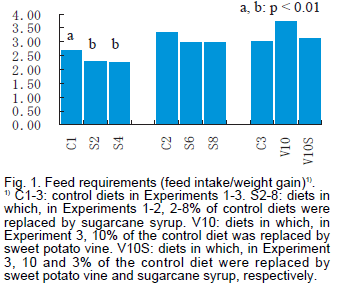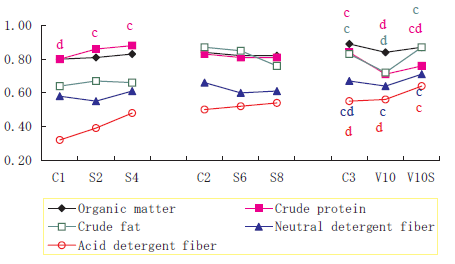Effects of sugarcane syrup in pig diets on feed requirements and nutrient digestibility in the Mekong Delta region of Vietnam
Description
In the Mekong Delta region, one of the two major grain-producing areas of Vietnam, a very high percentage of raw rice bran is used as pig feed. Farmers also use commercial feed to compensate for nutritional imbalances, but its high cost often places a financial burden on the producers. Hence, greater usage of locally available but underutilized feed resources such as water spinach (Ipomoea aquatica) and water hyacinth (Eichrornia crassipes) is being encouraged. The results of our previous studies revealed that there is enough of each species to supply up to 5-6% of the diet on a dry matter basis and to replace commercial feed without any reduction in growth performance; and with lower feed costs and higher pork prices, feeding water plants to pigs proved beneficial in terms of both production rate and market value. An agricultural by-product, sweet potato (Ipomoea batatas L.) vine (SPV), was also tested and showed positive results. On the other hand, sugarcane (Saccharum officinarum) by-products, such as molasses and bagasse, are currently being used as animal feed. However, there is little study on sugarcane syrup (SCS), an intermediate product made from sugarcane juice by boiling for several hours to evaporate the water. SCS is as palatable to the animal as the juice, and can be stored for much longer periods than the juice. The present study focused on the efficiency of additional levels of the SCS and its combination effect with an excess amount of green feed, SPV, on feed requirements and nutrient digestibility of pigs.
Three experiments were conducted in a study using basal diet with a high percentage of rice bran. In the first two experiments, 0- 8% of control diets were replaced by SCS to formulate treatment diets. In the third experiment, the treatment diets contained 10% SPV, or 10% SPV and 3% SCS. The results can be summarized as the following five points: first, the daily weight gain tended to increase or significantly increase as a result of supplementation with 2 or 4% SCS, respectively; second, there were no differences in feed intake among the diets in each of the three experiments; third, the feed requirement was improved by supplementation of 2-4% SCS, and tended to improve by supplementation of 6-8% SCS (Fig. 1); fourth, the digestibility of crude protein (CP) was improved, and that of acid detergent fiber (ADF) tended to be improved by 2-4% SCS supplementation; fifth, 10% SPV supplementation tended to have a negative effect on weight gain and feed requirement compared with no supplementation, but these effects were counteracted by the addition of 3% SCS (Figs. 1 and 2). The same patterns were found for the digestibility of CP and crude fat (CF). Although the digestibility of neutral detergent fiber and ADF were not affected by the supplementation of 10% SPV, that of ADF was increased by the addition of SCS. Overall, 4% SCS in the diet was optimal to improve weight gain and satisfy the feed requirements of pigs. Furthermore, SPV could be used at up to 10% with no negative effects on weight gain, feed requirement, or digestibility of CP and CF, provided 3% SCS was also added to the diet. The presence of several effects of SCS on growing performance and digestibility was indicated, although it is not clear which nutritional ingredient affects which parameters. In addition, the application of SCS with higher percentage of green plants, such as water plants and agricultural by-products, in the diet is of great interest, since huge amounts of these green plants are available in the region, although the productivity of some of these shows seasonal changes.
Figure, table
-
Fig. 1. Feed requirements (feed intake/weight gain)1).
1) C1-3: control diets in Experiments 1-3. S2-8: diets in which, in Experiments 1-2, 2-8% of control diets were replaced by sugarcane syrup. V10: diets in which, in Experiment 3, 10% of the control diet was replaced by sweet potato vine. V10S: diets in which, in Experiment 3, 10 and 3% of the control diet were replaced by sweet potato vine and sugarcane syrup, respectively. -
Fig. 2. Digestibility (%)1).
1)See Fig. 1. c, d: p < 0.05.
- Affiliation
-
Japan International Research Center for Agricultural Sciences Animal Production and Grassland Division
- Term of research
-
FY2004
- Responsible researcher
-
YAMASAKI Seishi ( Animal Production and Grassland Division )
MANH Luu Huu ( Can Tho University )
DUNG Nguyen Nhut Xuan ( Can Tho University )
- ほか
- Publication, etc.
-
Manh, L. H., Dung, N. N. X., Yamasaki, S. and Takada, R.(2003) : Effect of supplement of sweat potato vines (Ipomoea batatas (L.) lam.)with or without sugar cane syrup on performance and digestibility of growing pigs. Proceedings of the Final Workshop of JIRCAS Mekong Delta Project, 152-157.
- Japanese PDF
-
2004_12_A3_ja.pdf668.91 KB


